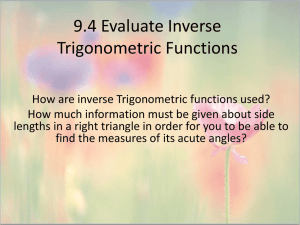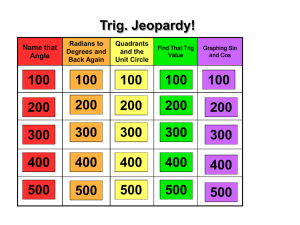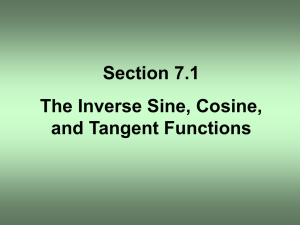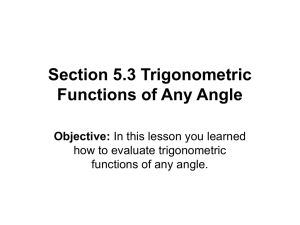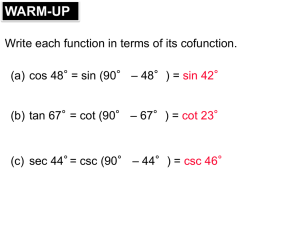Lesson6(students)
advertisement
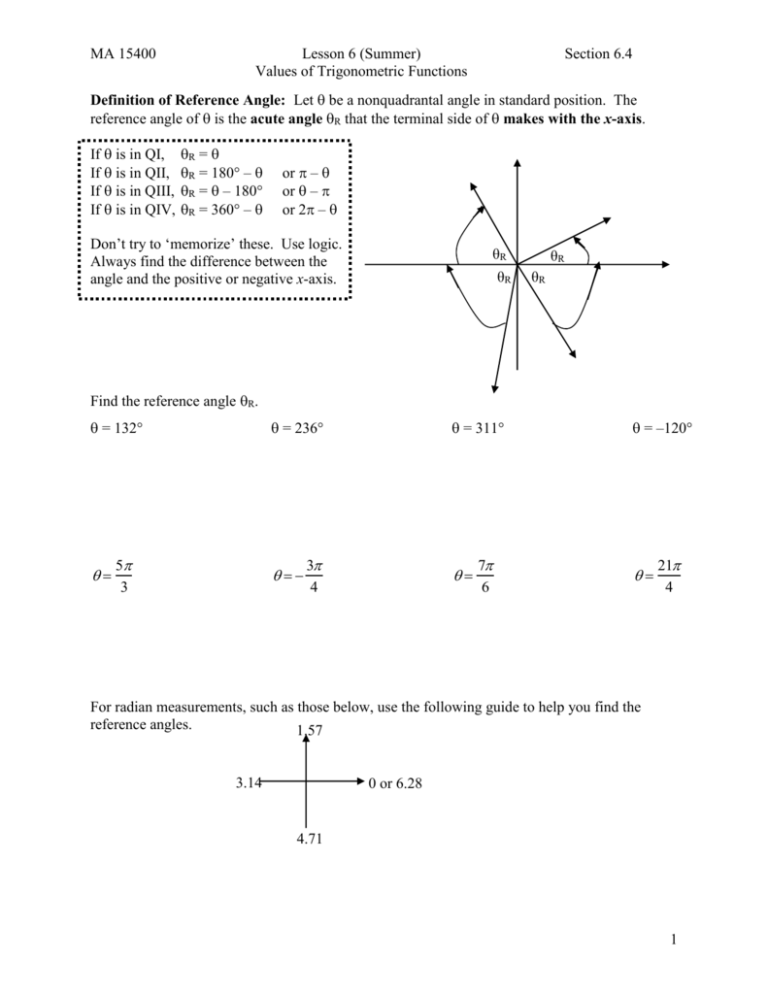
MA 15400 Lesson 6 (Summer) Values of Trigonometric Functions Section 6.4 Definition of Reference Angle: Let be a nonquadrantal angle in standard position. The reference angle of is the acute angle R that the terminal side of makes with the x-axis. If is in QI, If is in QII, If is in QIII, If is in QIV, R = R = 180 – R = – 180 R = 360 – or – or – or 2 – Don’t try to ‘memorize’ these. Use logic. Always find the difference between the angle and the positive or negative x-axis. θR θR θR θR Find the reference angle R. = 132 = 236 5 3 = 311 3 4 7 6 = –120 21 4 For radian measurements, such as those below, use the following guide to help you find the reference angles. 1.57 3.14 0 or 6.28 4.71 1 MA 15400 = 1.2 Lesson 6 (Summer) Values of Trigonometric Functions = 2.3 = 3.6 Section 6.4 = 5.6 To Find Trigonometric Values of an Angle: 1. Determine the quadrant where the terminal side is located 2. Find the reference angle 3. From the quadrant, determine if the value’s sign is + or 4. Find the value with the correct sign Find the exact value. sin(135) cos(240) tan( 210) cos(390) 5 sin 4 11 tan 3 11 sin 6 7 cos 4 7 tan 6 3 csc 4 5 cot 3 5 sec 3 2 MA 15400 Lesson 6 (Summer) Values of Trigonometric Functions Section 6.4 When Using A Calculator: 1. Have calculator in the correct mode 2. If finding a sine, cosine, or tangent value; press the correct key 3. If finding a secant, cosecant, or cotangent value; find the reciprocal function value first, then use the reciprocal key Approximate to three decimal places. cos 1547' sin 2.34 cot 12728' sec0.45 csc5.26 tan 75 So far you have been given an angle and asked to find a value; in other words given a domain value (x or θ), then find a range value (y or a number). For the inverse functions, you will be given the value and asked to find the angle (in either radians or degrees). A function must be one-to-one in order to have an inverse function; it must pass a horizontal line test. Graphs of the sine, cosine, and tangent functions show that these functions are not 1-1 and would not have inverses unless the domain of these functions is restricted. The inverse of the cosine function is only defined in the 1st and 2nd quadrants (for angles between 0 and 180 degrees or 0 to π radians). When you use the inverse cosine key on your calculator it will always return either a positive (1st quadrant) or a positive (2nd quadrant) angle. The inverse of the sine is only defined in the 1st and 4th quadrants (for angles between -90 and 90 degrees or to radians). When you use the inverse sine key on your calculator it will always 2 2 return either a positive (1st quadrant) or a negative (4th quadrant) angle. The inverse of the tangent function is the same as for inverse sine function and is only defined in the 1st and 4th quadrants. When you use the inverse tangent key on your calculator it will always return either a positive (1st quadrant) or a negative (4th quadrant) angle. 3 MA 15400 Lesson 6 (Summer) Values of Trigonometric Functions Section 6.4 The inverse sine, inverse cosine, and inverse tangent values on a calculator are found by using the 2nd key. They are labeled sin 1 , cos 1 , and tan 1 and are found above the sin, cos, and tan keys. Remember; you are given the value and finding an angle. To Find an Angle (inverse function) Given a Trigonometric Value: 1. Make sure your calculator is in the correct mode 2. Enter the value, use the 2nd key, and the correct function key 3. (If you are given a secant, cosecant, or cotangent value; first find the reciprocal of that value using the reciprocal key, then use the 2nd key and correct reciprocal function key.) 4. From the angle given, find the reference angle; then use it to find all angles in the given interval Approximate the acute angle to the nearest a) 0.01 and b) 1' cos = 0.3456 tan = 1.9064 Approximate to the nearest 0.1, all angles in the interval [0, 360) that satisfy the equation. sin = 0.4567 tan = -1.4826 sec = 1.4080 cos = –0.4617 cot = 2.4586 csc = –2.5896 4 MA 15400 Lesson 6 (Summer) Values of Trigonometric Functions Section 6.4 Approximate to the nearest 0.01 radians, all angles in the interval [0, 2) that satisfy the equation. cos = 0.2314 cot = – 0.5241 csc = 1.2665 sin = –0.9852 tan = 5.2683 sec = –2.7514 5

